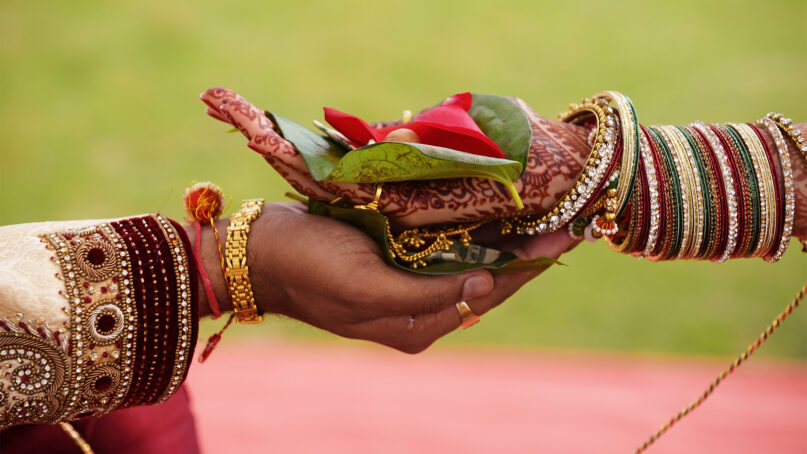(RNS) — In June my partner and I will make our contribution to the United States’ $51 billion wedding industry. Yes, weddings are about friends and family, but they are also about the cost. Weddings are expensive. Mine, which is going to cost more than my car, is in keeping with the national average of more than $22,000.
In my family, the expectations about a proper wedding are high. Indian weddings are lavish, colorful spectacles and have only become more so over time. Even in the U.S., where Indian weddings are often muted in comparison with those performed in India, the celebration involves several events; many guests; a flower-bedecked wedding platform or mandapa; an involved, lengthy ceremony; and lots of food.
Did I mention the food? The biggest driver of our costs is the number of guests we need to feed, which determines the cost of catering and alcohol.
Here is where the wedding megamarket operates against a religious and ethnic minority like me. My mostly South Indian family expects a reception dinner with Indian cuisine. My partner and I have looked at over a dozen wedding venues, and most had a list of preferred caterers — some places banned any caterer not on their list outright, while others merely charged an additional fee for using a caterer not on the preferred list.
RELATED: Digitizing sacred spaces: How COVID-19 fueled innovation of Hindu ritual websites
This practice is more common than you might think, and not only for caterers. Wedding venues make deals with florists, party rental agencies, wedding planners, photographers, DJs and other vendors to offer couples an all-in-one wedding experience. For most couples, this makes perfect sense. After all, wedding planning is like having a second job; who wouldn’t want to save time by narrowing your options for these services?
But what if you don’t fit into the one-size-fits-all wedding package? Despite the growing number of South Asians in the U.S. and the relative cost of an Indian wedding, outside of large urban areas with sizable South Asian populations, the options for catering an Indian wedding remain slim.
This is the challenge we faced in Colorado, where the South Asian population is estimated at about 30,000. Several wedding venues in our area listed a single high-end catering outfit that could provide north and south Indian meals as a preferred caterer. Though well-reviewed and well-versed in Indian cuisine, the caterer was also by far the most expensive one on many lists.
If we chose to cater our wedding with barbeque rather than biryani, of course, we could avoid the problem. But the lack of choice amounts to a costly extra premium for falling outside of the local cultural norms.

A traditional curd rice dish. Photo by Sumeet B/Unsplash/Creative Commons
Is this “Hinduphobia”? No. It is an example of how markets shape ethnic and cultural practices or trivialize them as exotic excursions for the wealthy. Since Indian or Hindu weddings are a niche product in the wedding industry, venues and caterers have little incentive to consider the impact of their policies on such weddings.
While it’s true that businesses can’t consider every possible customer, the wedding industry is in the business of selling experiences: Weddings are cultural events. One-stop-shop weddings that center Christian conventions with “American” menus might maximize profits for their vendors, but they also make a statement about what kind of weddings are important and which need to pony up for access. It’s just the cost of being “other.”
One solution to my problem would be for venues to offer flexibility and affordability to those for whom the one-stop-shop wedding actually represents less convenience and more cultural exclusion.
But the wedding industry isn’t the only example of the way markets flatten ethnic and cultural diversity and capitalize on uniqueness. Cosmetic and hair care companies, many of which were historically indifferent to nonwhite skin tones or “ethnic” hair, now often charge more for these “specialized” products. Clothing companies that offer “exotic” ethnic and Indigenous styles to wealthy white customers and jewelry companies that promote their brand only through a heteronormative view of love also seek to monetize difference.
In each case, the market determines how much more the privilege of access will cost or if it’s even available. The bottom line: Cultural difference costs more.
Weddings are intended to be unique, once-in-a-lifetime experiences in which families come together to celebrate a couple’s new beginning, their life together. But having an Indian wedding means that uniqueness may come at an additional cost.
RELATED: Namaste nationalism: Yoga, whiteness and extremism on Jan. 6
Moreover, such a practice further isolates those with niche cultural backgrounds and effectively sends the message that certain communities will have to pay extra for “equal” access. Why should there be a surcharge for having a Hindu wedding?
This column is produced by Religion News Service with support from the Guru Krupa Foundation.
(Dheepa Sundaram is an assistant professor of religious studies at the University of Denver who writes about digital culture, yoga, nationalism and religion. The views expressed in this commentary do not necessarily reflect those of Religion News Service.)





